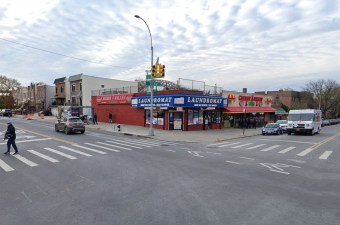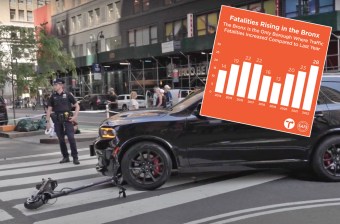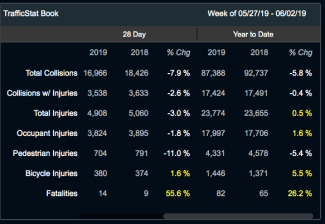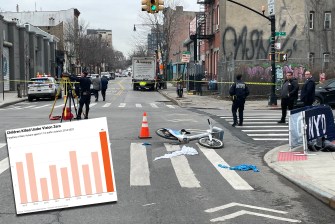Cyclist Deaths Soared in the First Three Months of 2023, On Pace for Worst Year in History

A staggering 10 cyclists have died in the city so far this year — the highest death tally for that time period in at least a decade and a five-fold increase compared to 2022, according to the Department of Transportation.
Deaths among e-scooter and e-moped riders rose slightly from three to four between Jan. 1 and April 5 this year, while road fatalities overall dipped from 58 to 54, thanks to two fewer pedestrians killed and a drop by nearly half in deaths of people inside cars, from 22 to 12, DOT said.
Advocates called on Mayor Adams and DOT to do more more to curb the lethal trend.
“We’re alarmed by the increase in bike riders killed in traffic violence so far this year,” said Transportation Alternatives spokesman Jacob deCastro. “Mayor Adams and Department of Transportation Commissioner [Ydanis] Rodriguez must build physical infrastructure to protect people riding bikes, especially in areas the city knows to be dangerous, and meet the NYC Streets Plan requirement of 50 miles of protected bike lanes this year.”
This year’s grim death toll is unmatched since at least 2013. The next-closest number, six, was in 2019, which ended as the deadliest year for New York City bicyclists in two decades, with 28 cyclists killed by year’s end (meaning this year is on pace to be the worst year for cyclists … ever). During the last such wave of carnage, then-Mayor Bill de Blasio declared the carnage an “emergency” and responded with increased investment in safe bike infrastructure.

Cyclists and e-mobility riders — DOT labels the latter “other motorized” — often rely on the same bike lane infrastructure, which the Adams administration has failed to expand fast enough, advocates charged. DOT fell short of its legally required 30 miles of newly installed protected bike lanes in 2022, and officials will have to set up 50 miles of the green-painted paths annually each coming year.
“We hesitate to read too much into a few months of data, but this loss of life signals that the city is still tinkering at the margins with street safety,” said Jon Orcutt, director of advocacy at Bike New York.
Injuries, which are a more statistically important measure of road safety than fatalities, were also up among cyclists and e-device users, increasing 18 percent and 26 percent year-to-date through April 2 respectively, according to NYPD stats.
Cyclist injuries are above the citywide increase in The Bronx (where injuries are up 28 percent this year), upper Manhattan (up 22 percent), all of Queens (up 40 percent) and Staten Island, where cycling injuries are up from three over the first part of 2022 to 10 in the same period this year, an increase of 233 percent.
The injuries were concentrated in Harlem and the Upper East Side in Manhattan; Downtown Brooklyn, Williamsburg, Bushwick, East Flatbush, and Sunset Park in Brooklyn; Sunnyside, Astoria, and Elmhurst in Queens; and the Bronx’s Mott Haven, Soundview, and Kingsbridge neighborhoods.
The spate of cyclist killings began shortly after the new year when a cement truck driver ran down and killed 62-year-old local Tamara Chuchi Kao. The driver was not charged.
The bloodshed also includes crashes in residential areas and busy commercial strips:
- Brooklyn mom Sarah Schick was killed 10 days into the new year when a trucker ran her over as she rode a Citi Bike. The mother-of-two died on an industrial stretch of Ninth Street where DOT had opted not to extend a protected bike lane. After activists held a “die-in,” the DOT said it would redesign the stretch, but the truck driver has not been charged.
- Cyclist James Giambalvo was killed on a quiet street in Staten Island in February. His killer has not been brought to justice.
- A hit-and-run driver hit delivery worker Hua Pan on April 5 in The Bronx. That driver has not been caught.
Unseasonably warm weather corresponded with more people riding around on two wheels in January and February, but DOT officials insisted it was too soon in the year to identify any trends in the data.
“The cyclist fatalities this year have been heartbreaking,” agency spokesman Vin Barone said in a statement. “DOT works every day to curb traffic fatalities through Vision Zero, including building high-quality bike lanes; installing barriers along existing lanes; and developing new designs to support the growing use of micro-mobility.”
The relative rate of cyclists killed or seriously injured per 10 million trips has declined over the past two decades as more people have started riding, according to data through 2018, Barone noted.
“Historically, cycling in New York City became safer as more and more New Yorkers ride, with the risk of injury or death dropping over the years,” the spokesman said.
— with Gersh Kuntzman




